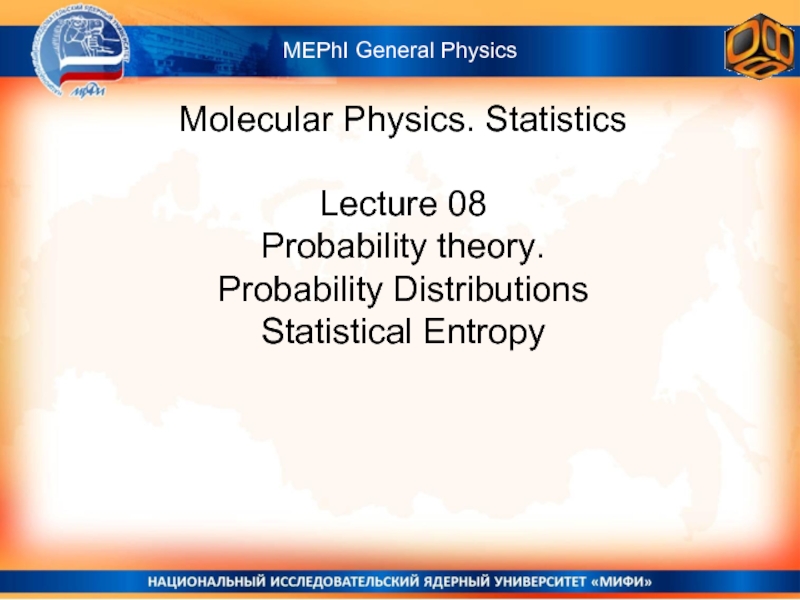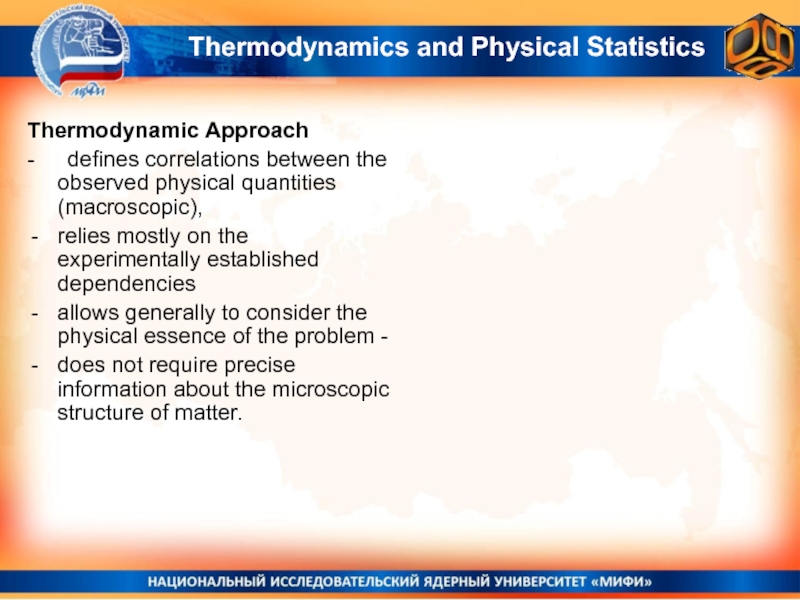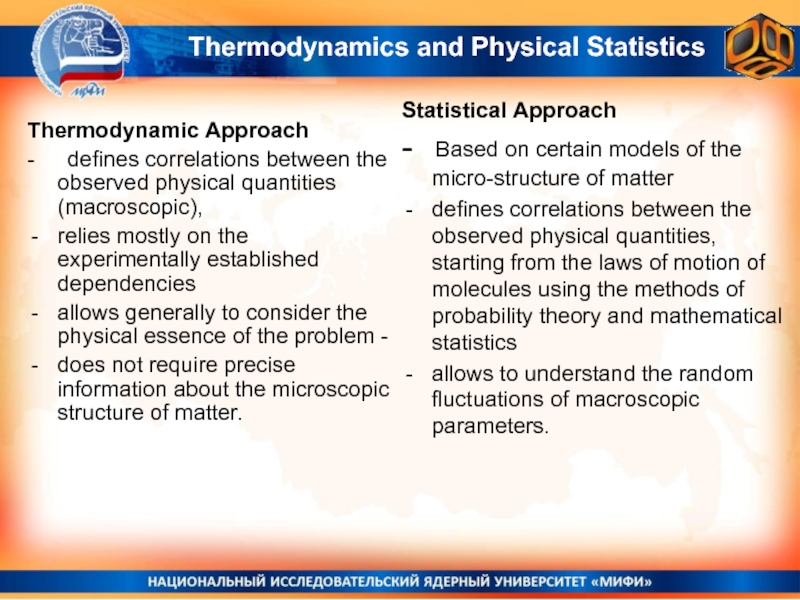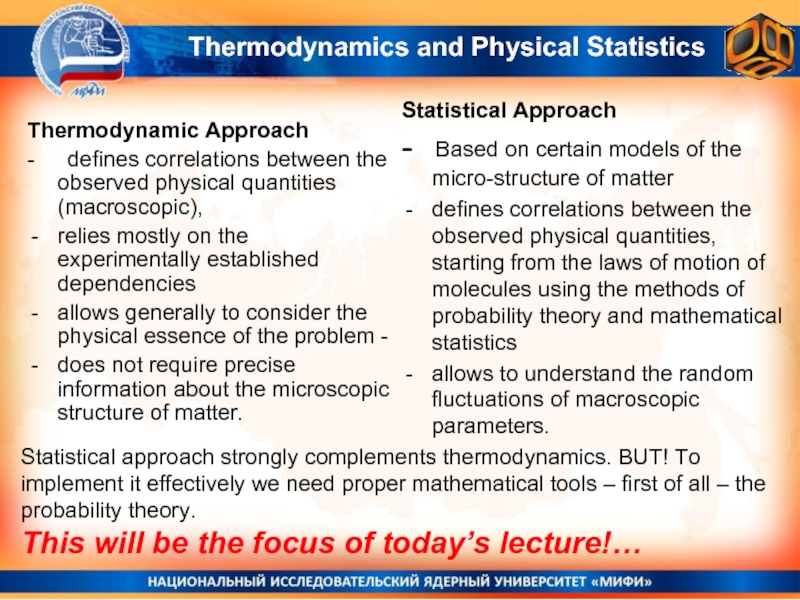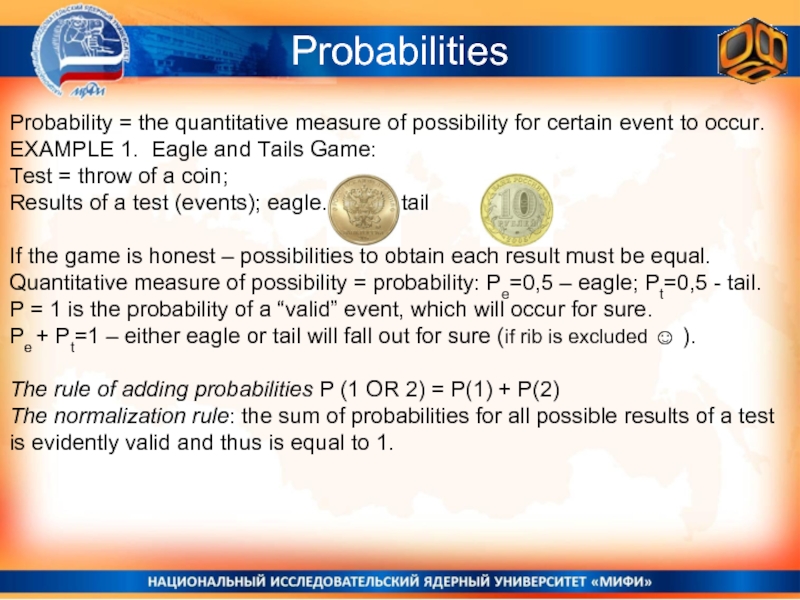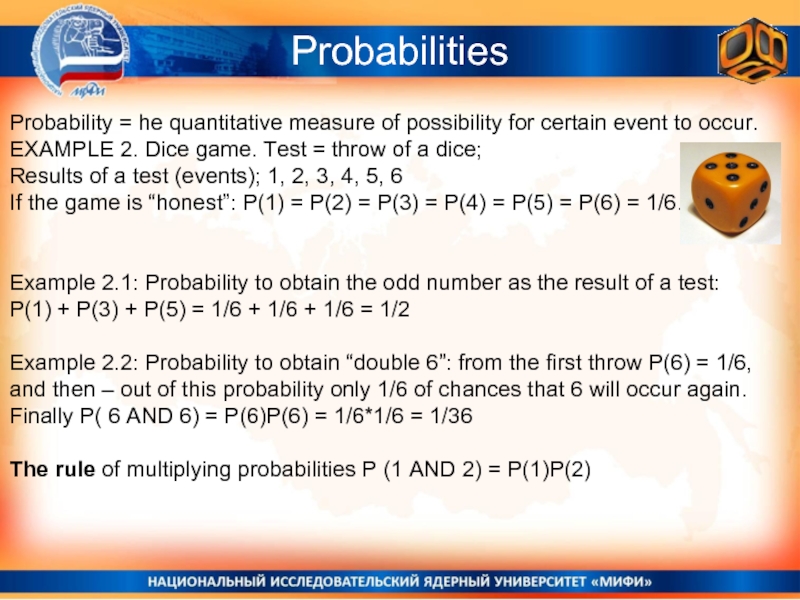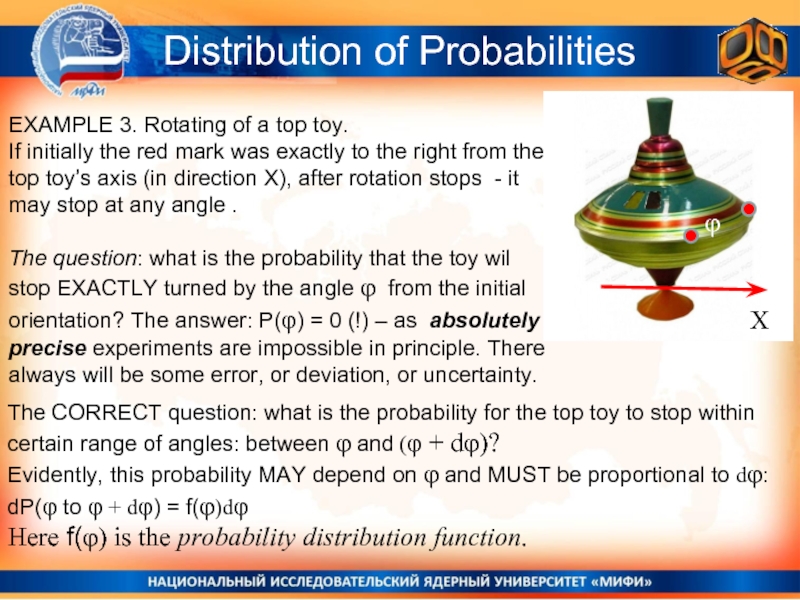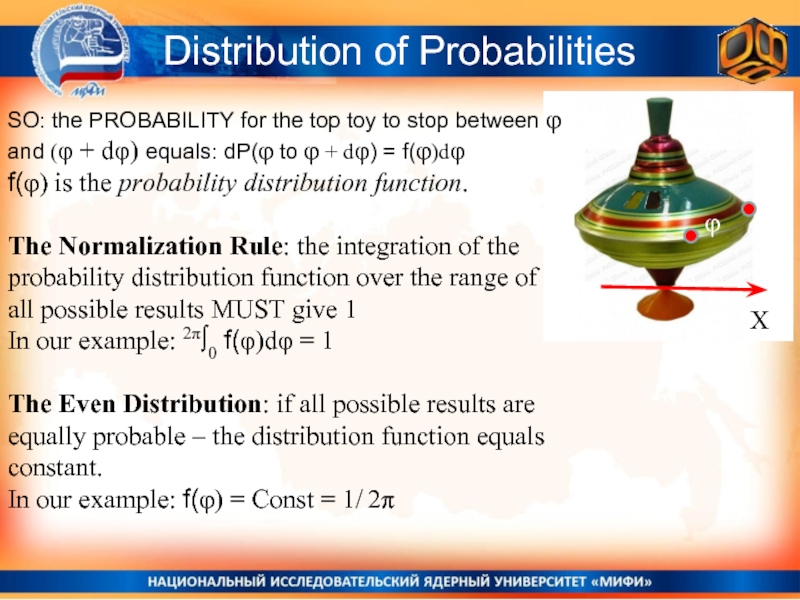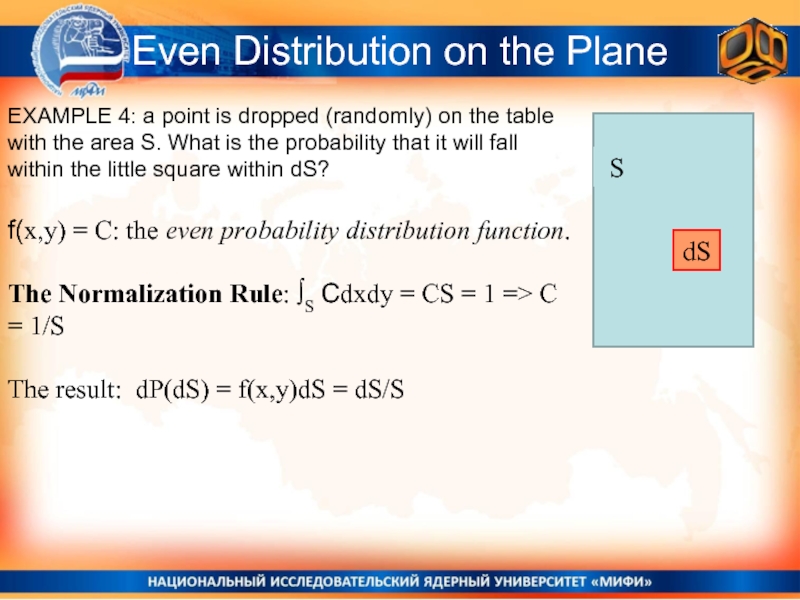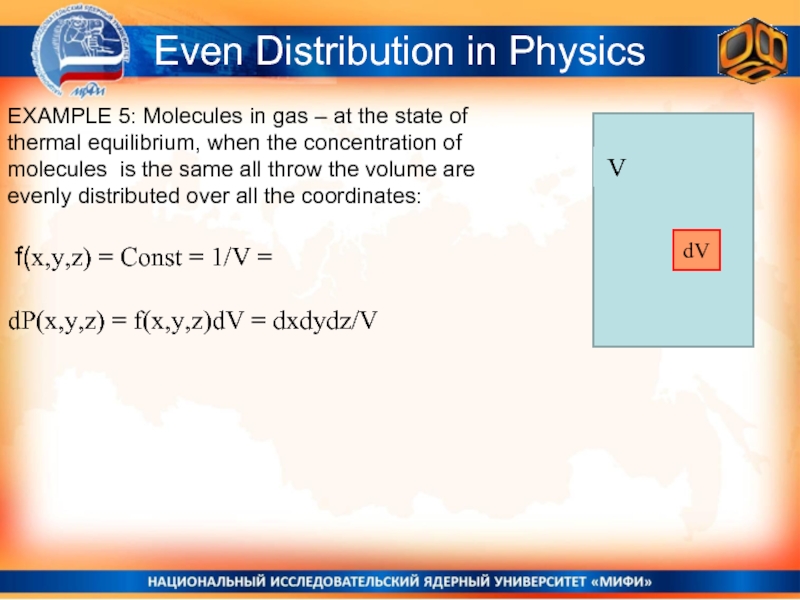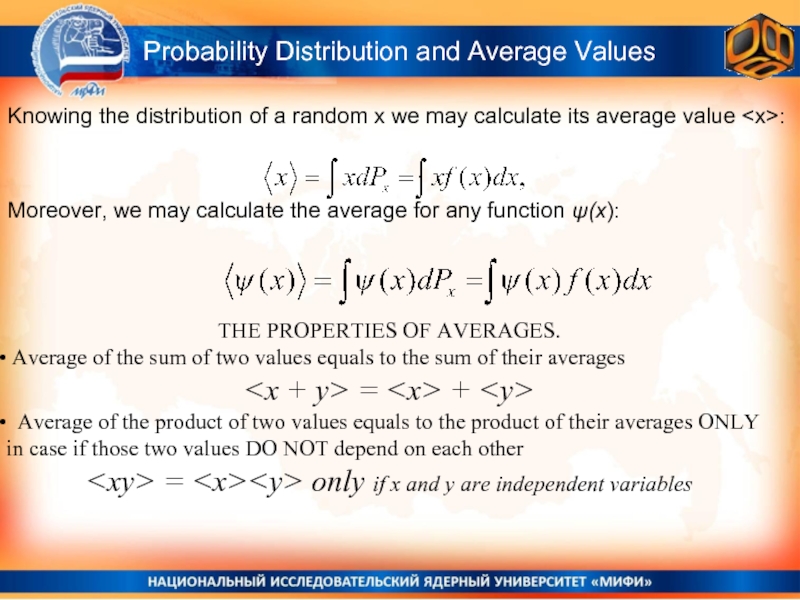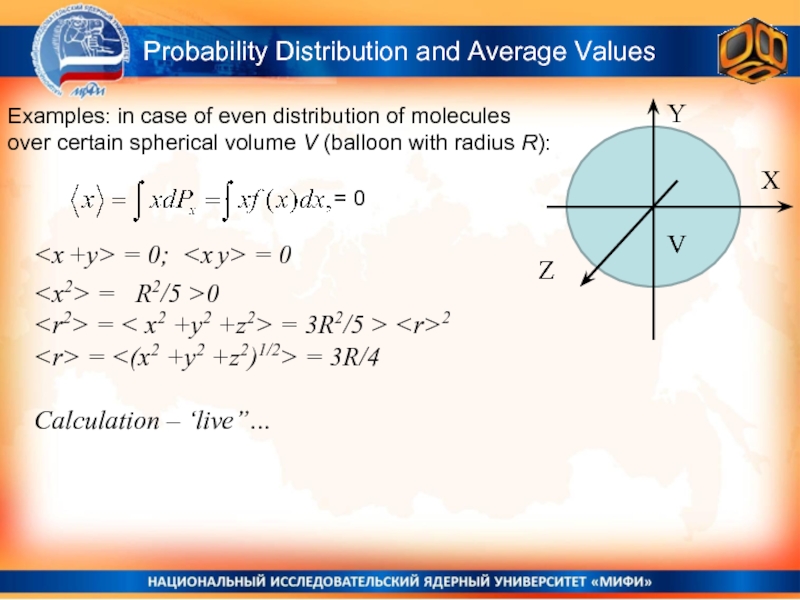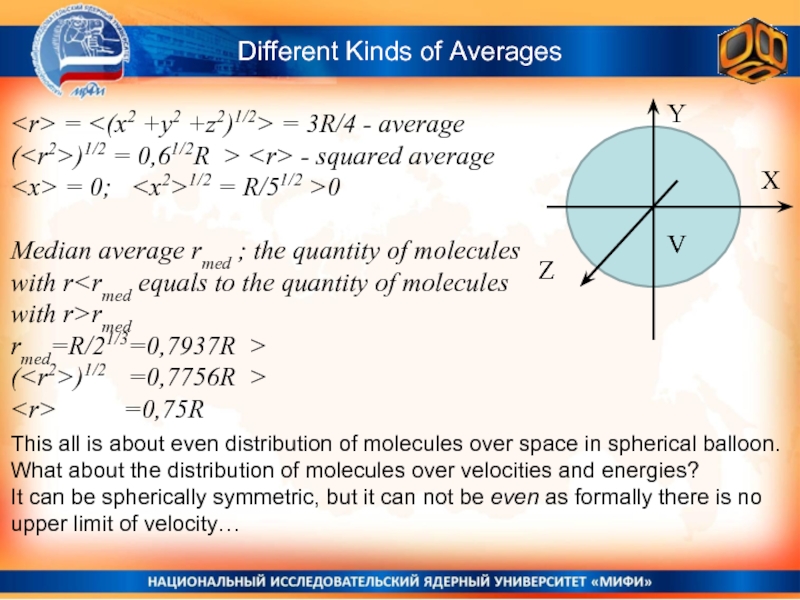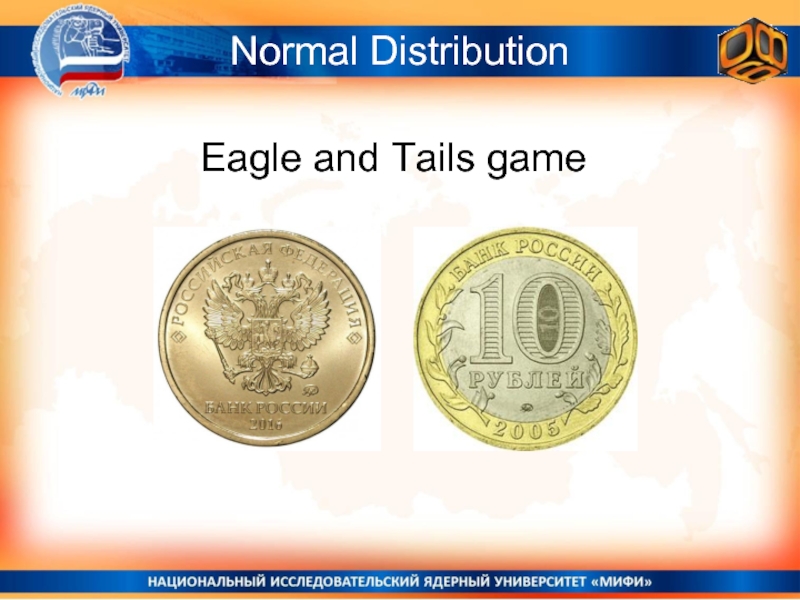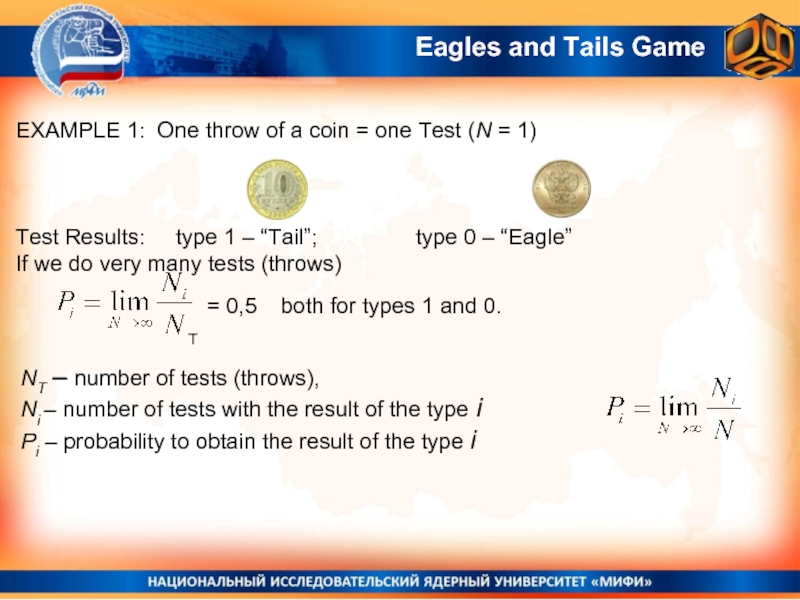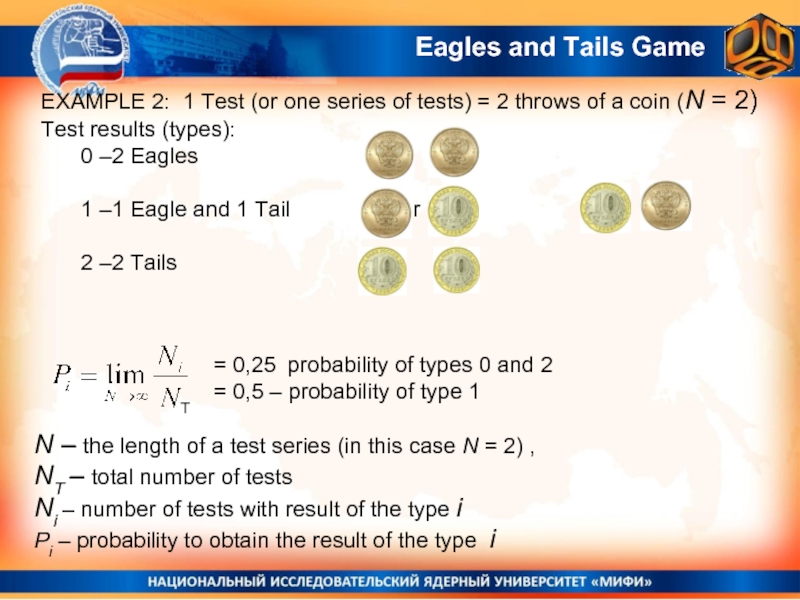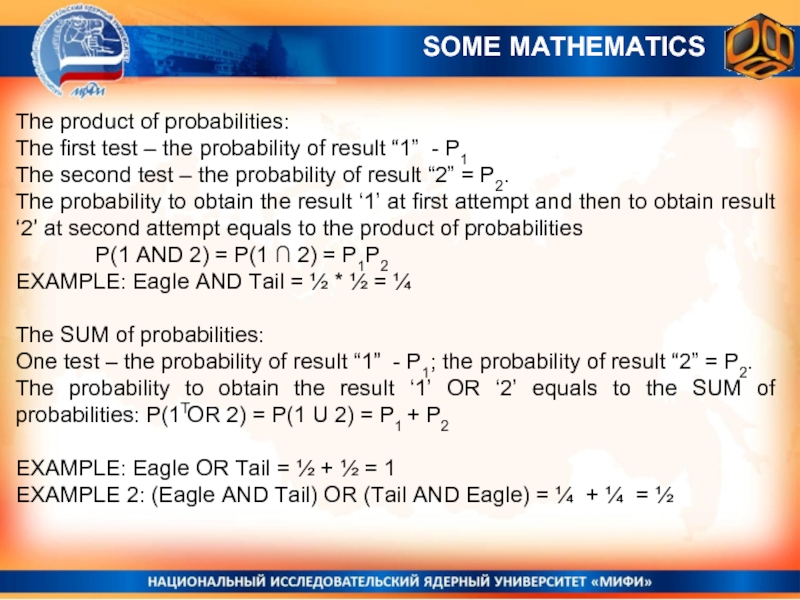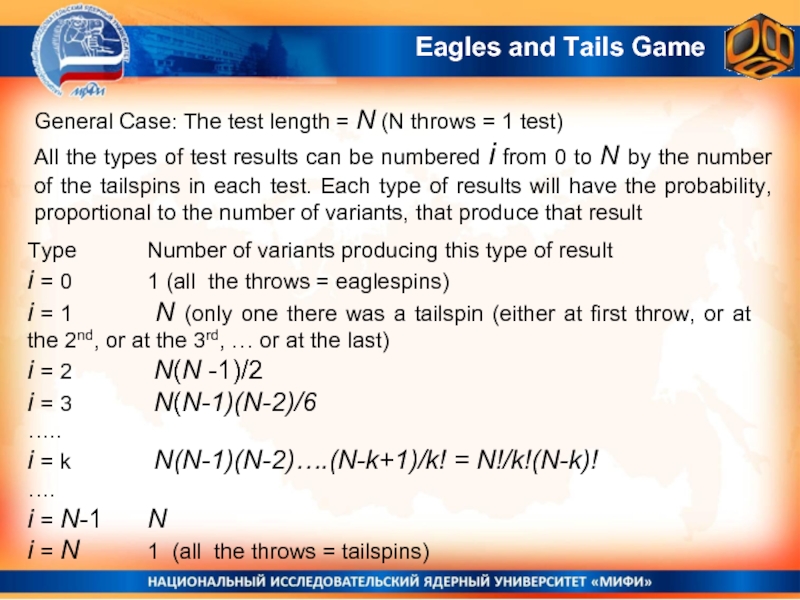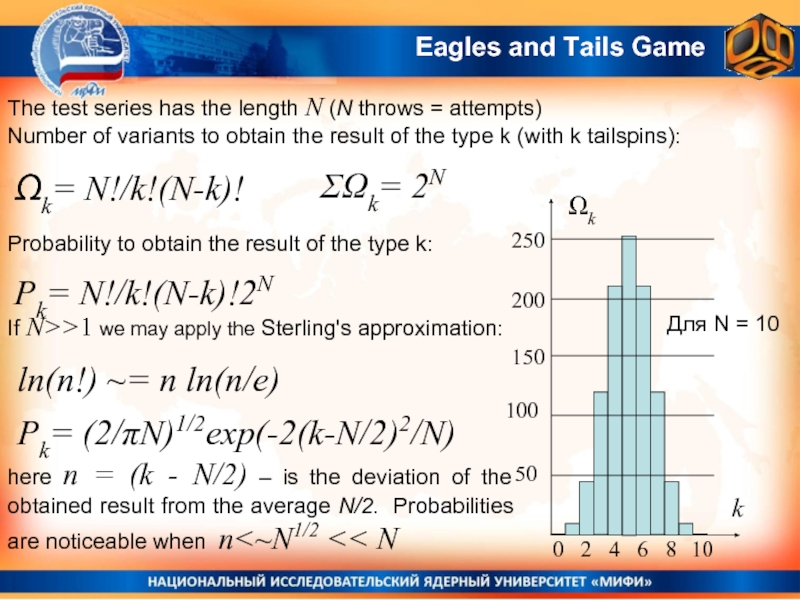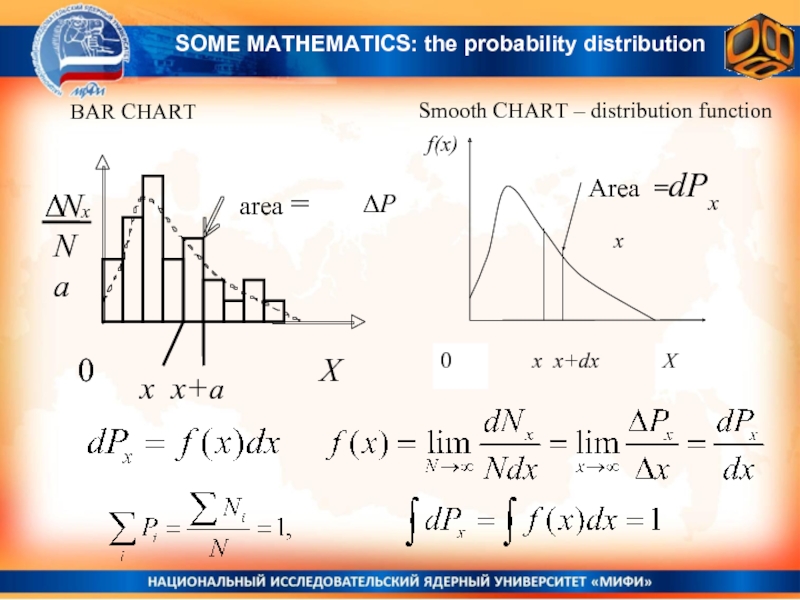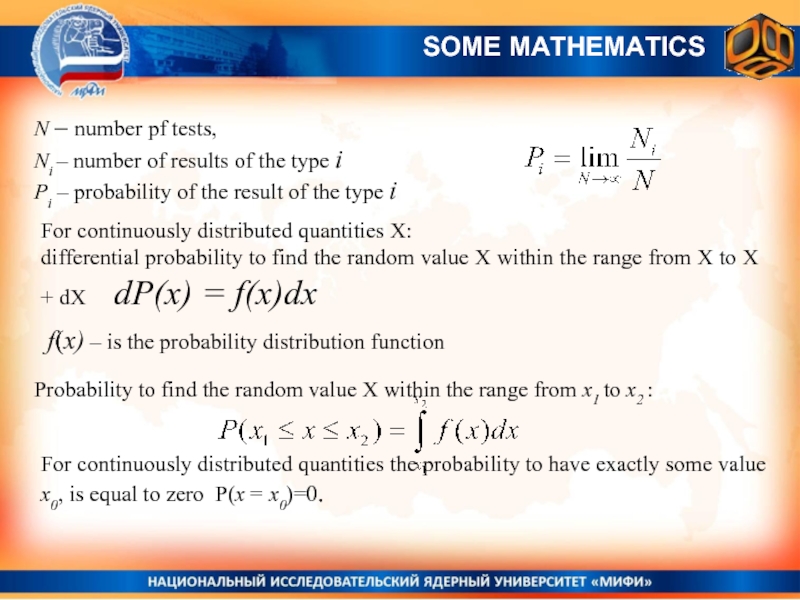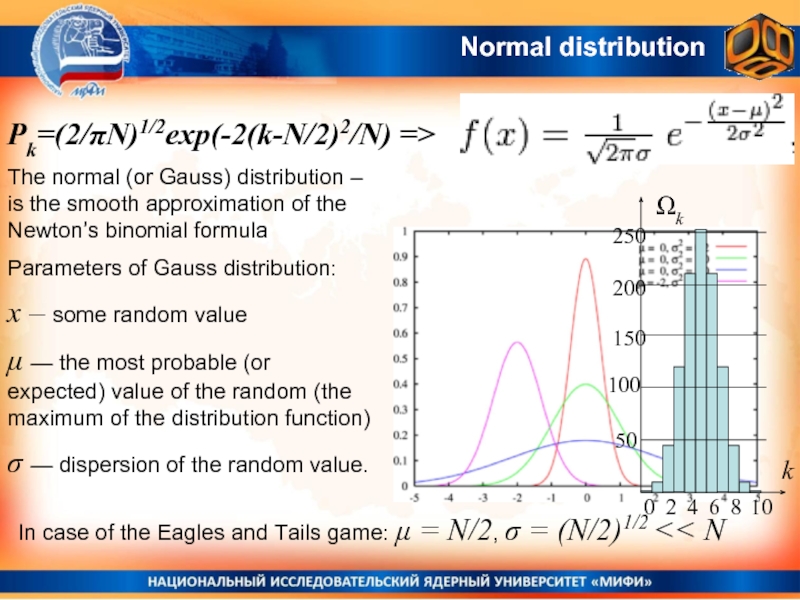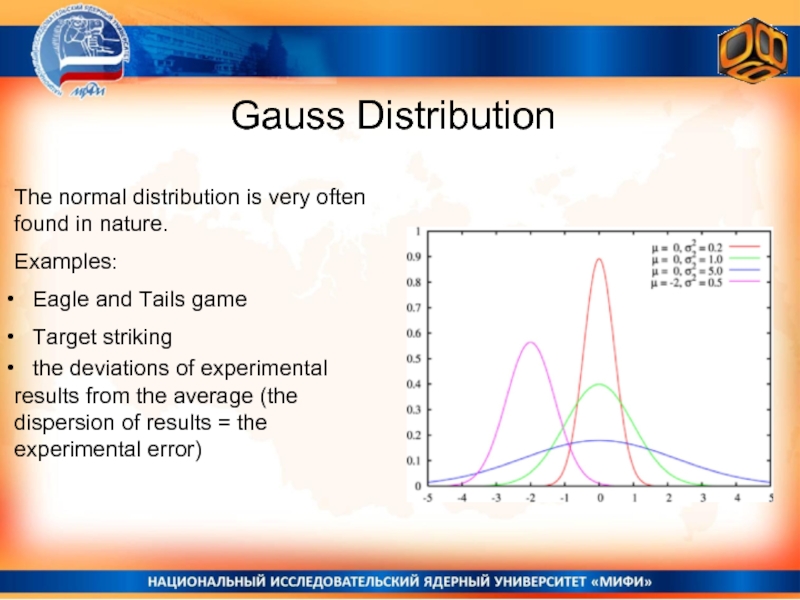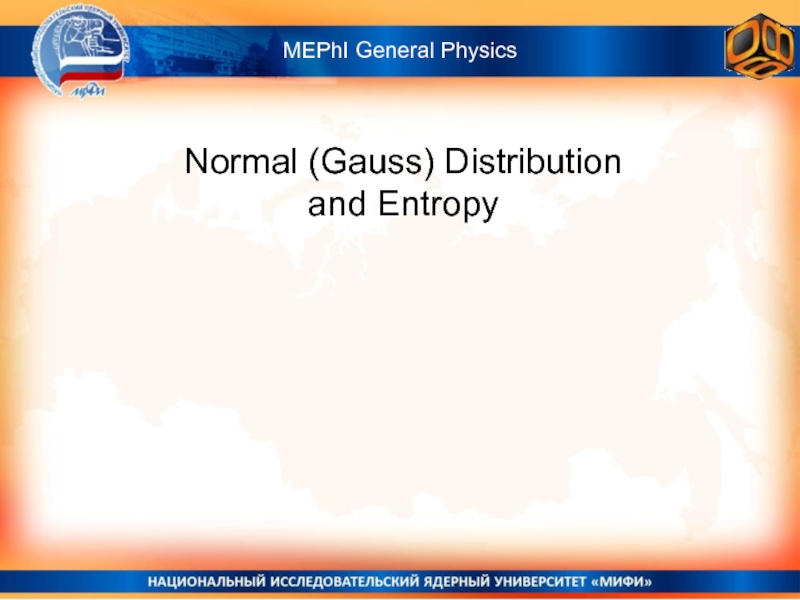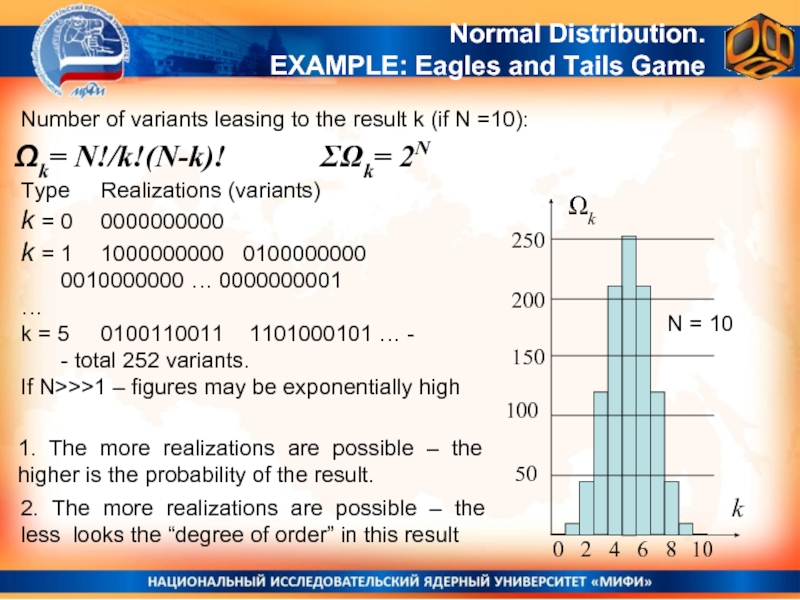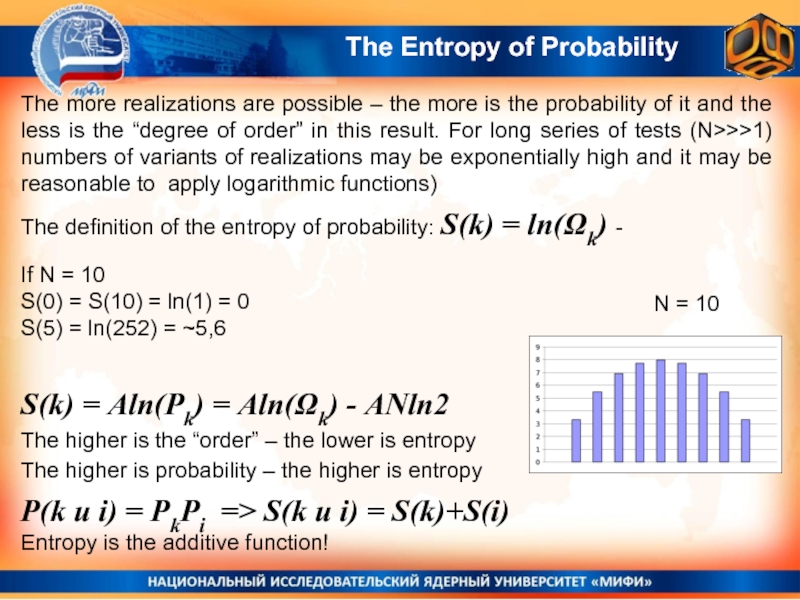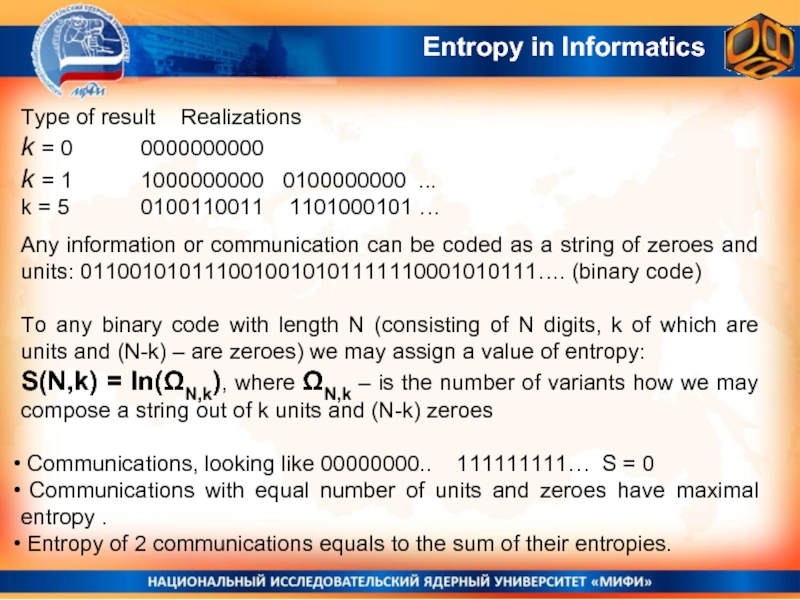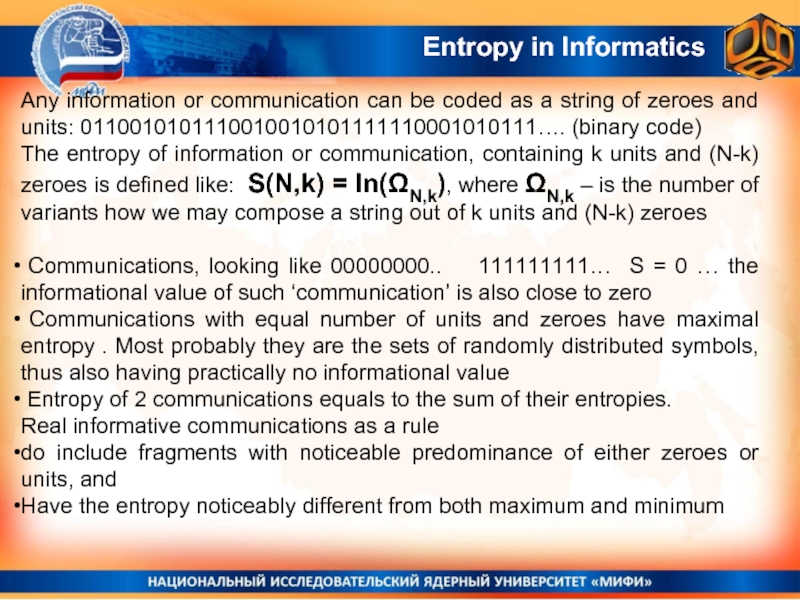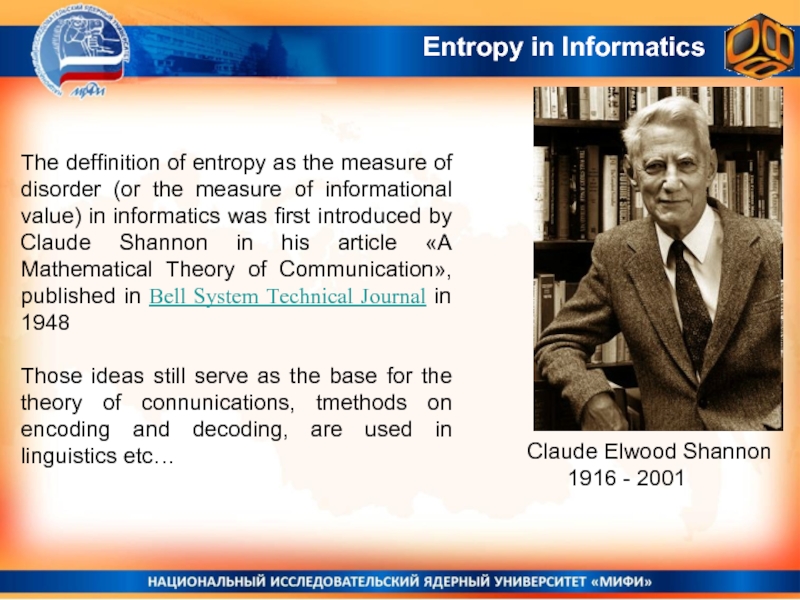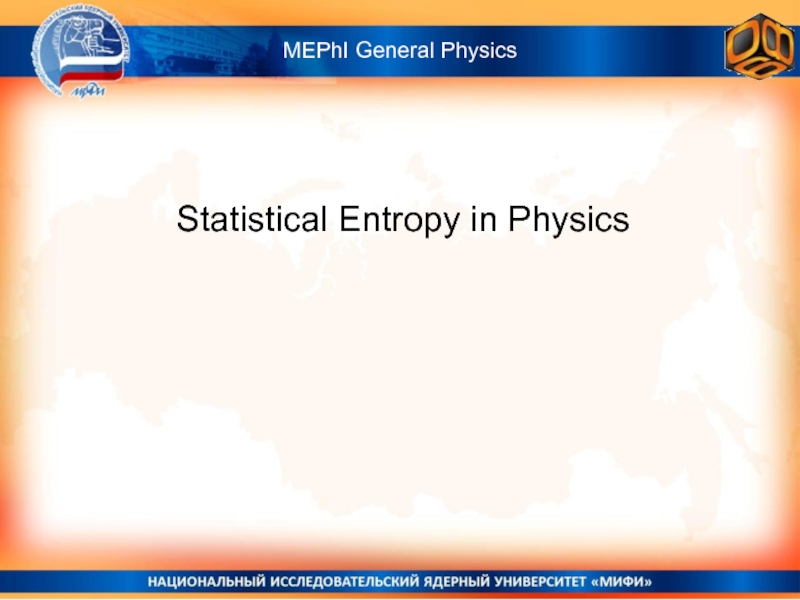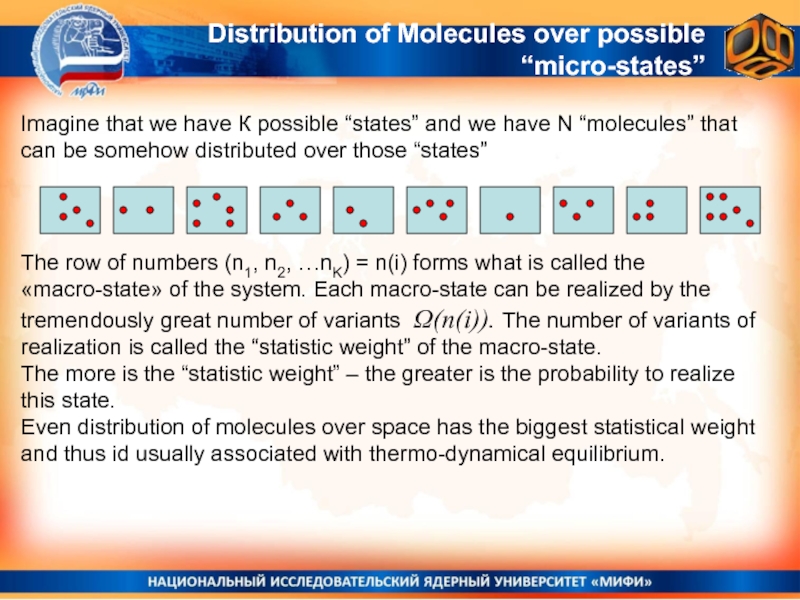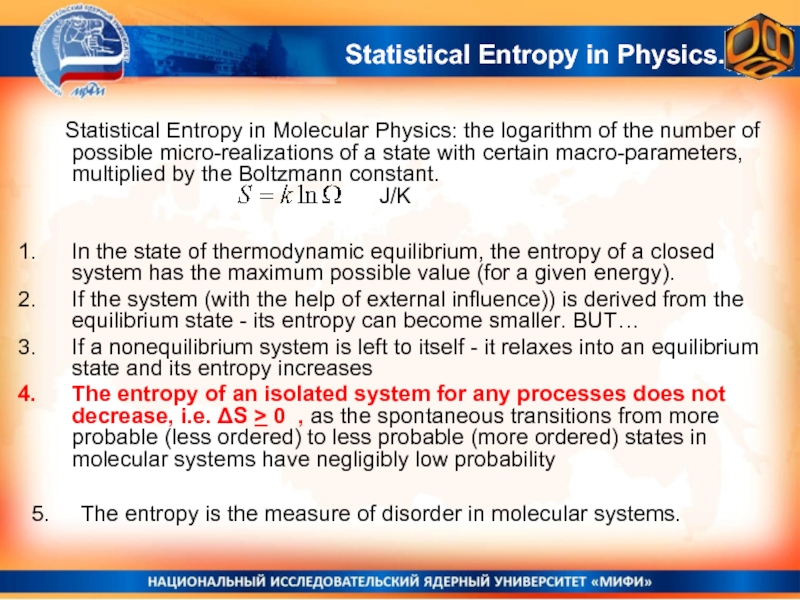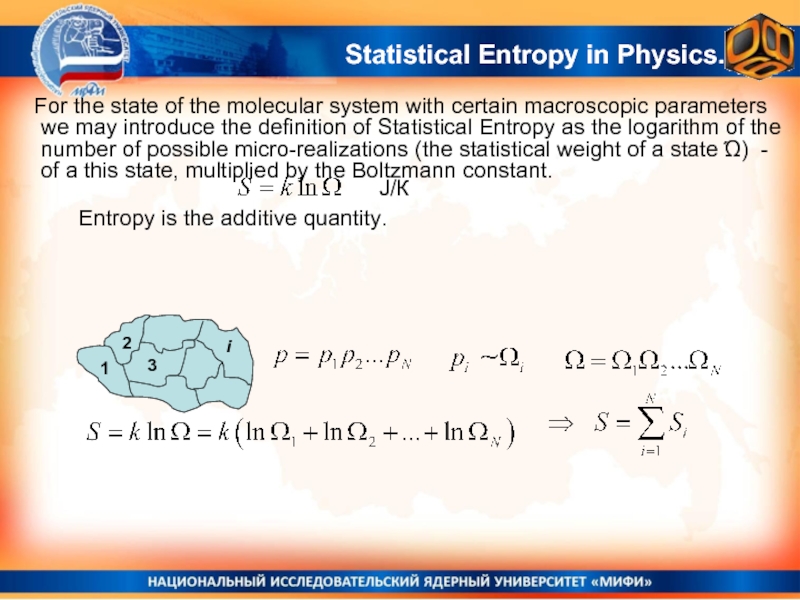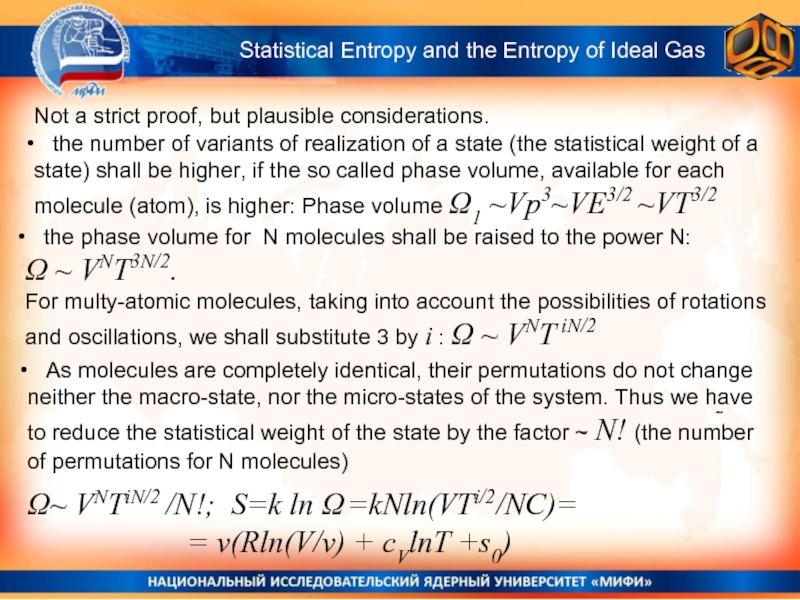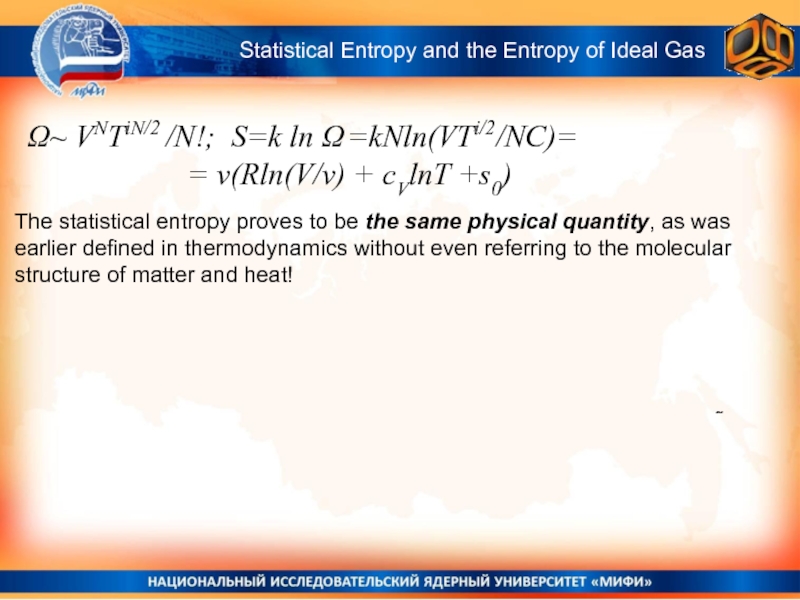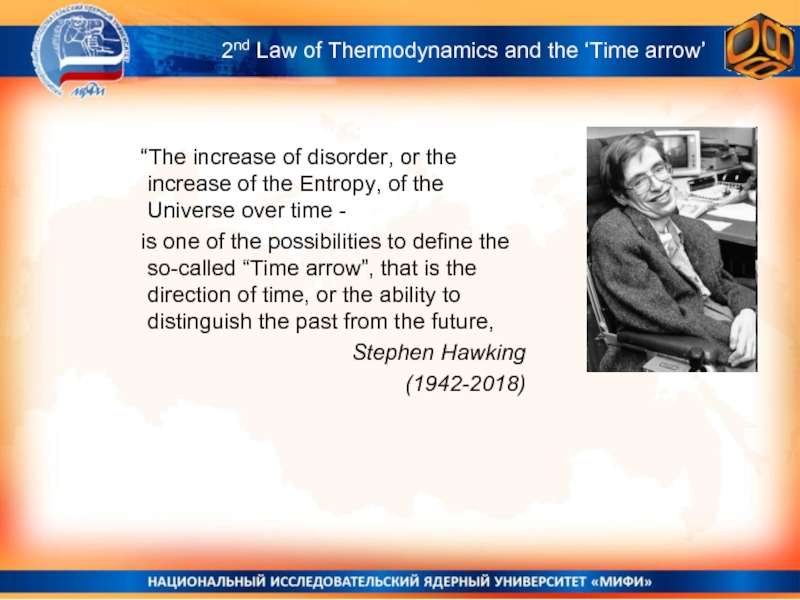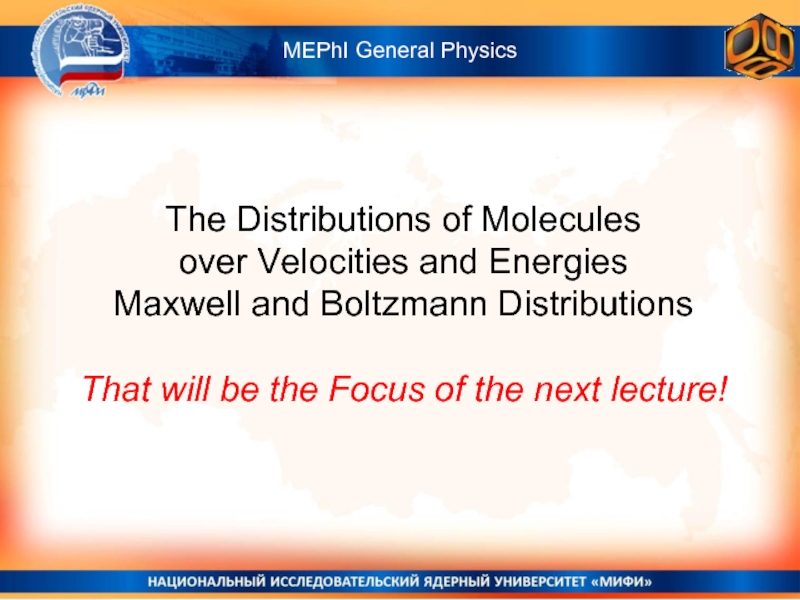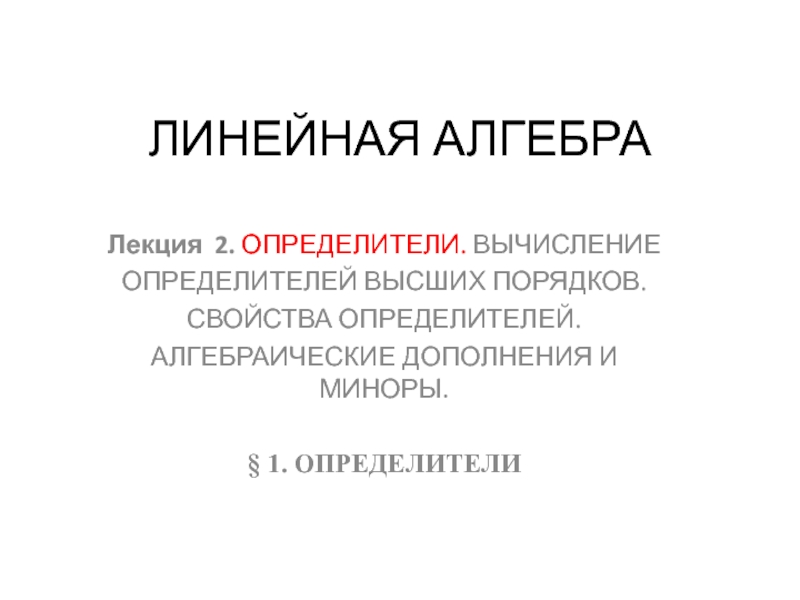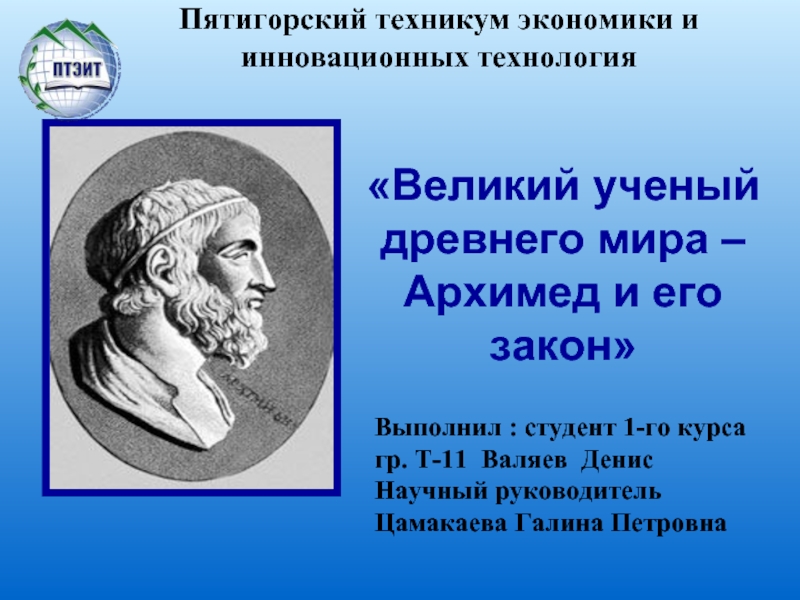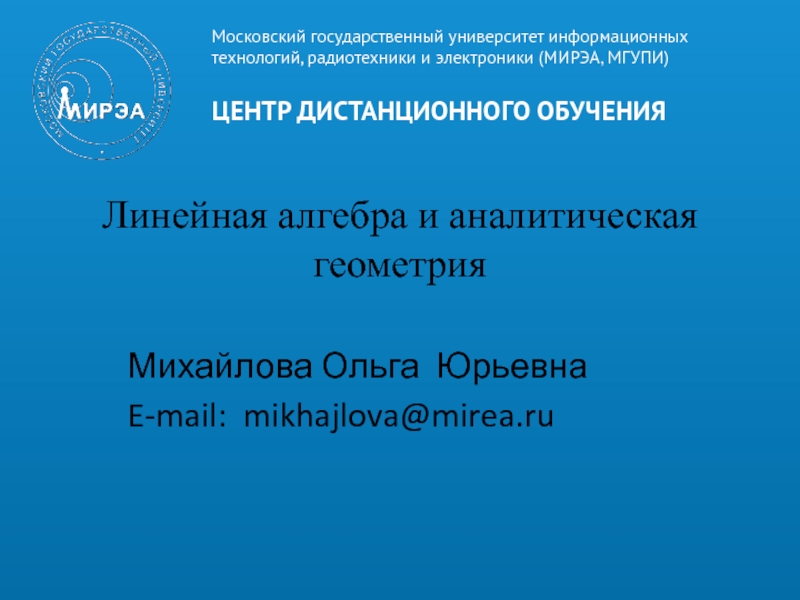- Главная
- Разное
- Дизайн
- Бизнес и предпринимательство
- Аналитика
- Образование
- Развлечения
- Красота и здоровье
- Финансы
- Государство
- Путешествия
- Спорт
- Недвижимость
- Армия
- Графика
- Культурология
- Еда и кулинария
- Лингвистика
- Английский язык
- Астрономия
- Алгебра
- Биология
- География
- Детские презентации
- Информатика
- История
- Литература
- Маркетинг
- Математика
- Медицина
- Менеджмент
- Музыка
- МХК
- Немецкий язык
- ОБЖ
- Обществознание
- Окружающий мир
- Педагогика
- Русский язык
- Технология
- Физика
- Философия
- Химия
- Шаблоны, картинки для презентаций
- Экология
- Экономика
- Юриспруденция
Probability theory. Probability Distributions Statistical Entropy презентация
Содержание
- 1. Probability theory. Probability Distributions Statistical Entropy
- 2. Thermodynamics and Physical Statistics Thermodynamic Approach
- 3. Statistical Approach - Based on
- 4. Thermodynamics and Physical Statistics Statistical approach
- 5. Probability = the quantitative measure of possibility
- 6. Probability = he quantitative measure of possibility
- 7. EXAMPLE 3. Rotating of a top toy.
- 8. Distribution of Probabilities X φ
- 9. Even Distribution on the Plane EXAMPLE 4:
- 10. Even Distribution in Physics EXAMPLE 5: Molecules
- 11. THE PROPERTIES
- 12. Probability Distribution and Average Values Examples: in
- 13. Different Kinds of Averages Y X
- 14. Eagle and Tails game Normal Distribution
- 15. Eagles and Tails Game EXAMPLE
- 16. EXAMPLE 2: 1 Test (or
- 17. The product of probabilities:
- 18. General Case: The test length
- 19. The test series has the
- 20. BAR CHART Smooth CHART –
- 21. N – number pf tests,
- 22. Normal distribution The normal (or Gauss) distribution
- 23. Gauss Distribution The normal distribution is
- 24. Normal (Gauss) Distribution and Entropy MEPhI General Physics
- 25. Number of variants leasing to
- 26. The Entropy of Probability The
- 27. Entropy in Informatics Type of
- 28. Entropy in Informatics Any information
- 29. The deffinition of entropy as
- 30. Statistical Entropy in Physics MEPhI General Physics
- 31. Distribution of Molecules over possible
- 32. Statistical Entropy in Molecular Physics: the logarithm
- 34. Not a strict proof, but plausible considerations.
- 35. ∼ Statistical Entropy and the Entropy of
- 36. 2nd Law of Thermodynamics and the ‘Time
- 37. The Distributions of Molecules
- 38. Thank You for Attention!
Слайд 1Molecular Physics. Statistics
Lecture 08
Probability theory.
Probability Distributions
Statistical Entropy
MEPhI General Physics
Слайд 2
Thermodynamics and Physical Statistics
Thermodynamic Approach
- defines correlations between the observed physical
relies mostly on the experimentally established dependencies
allows generally to consider the physical essence of the problem -
does not require precise information about the microscopic structure of matter.
Слайд 3
Statistical Approach
- Based on certain models of the micro-structure of
defines correlations between the observed physical quantities, starting from the laws of motion of molecules using the methods of probability theory and mathematical statistics
allows to understand the random fluctuations of macroscopic parameters.
Thermodynamics and Physical Statistics
Thermodynamic Approach
- defines correlations between the observed physical quantities (macroscopic),
relies mostly on the experimentally established dependencies
allows generally to consider the physical essence of the problem -
does not require precise information about the microscopic structure of matter.
Слайд 4
Thermodynamics and Physical Statistics
Statistical approach strongly complements thermodynamics. BUT! To implement
This will be the focus of today’s lecture!…
Thermodynamic Approach
- defines correlations between the observed physical quantities (macroscopic),
relies mostly on the experimentally established dependencies
allows generally to consider the physical essence of the problem -
does not require precise information about the microscopic structure of matter.
Statistical Approach
- Based on certain models of the micro-structure of matter
defines correlations between the observed physical quantities, starting from the laws of motion of molecules using the methods of probability theory and mathematical statistics
allows to understand the random fluctuations of macroscopic parameters.
Слайд 5Probability = the quantitative measure of possibility for certain event to
EXAMPLE 1. Eagle and Tails Game:
Test = throw of a coin;
Results of a test (events); eagle. or tail
If the game is honest – possibilities to obtain each result must be equal.
Quantitative measure of possibility = probability: Pe=0,5 – eagle; Pt=0,5 - tail.
P = 1 is the probability of a “valid” event, which will occur for sure.
Pe + Pt=1 – either eagle or tail will fall out for sure (if rib is excluded ☺ ).
The rule of adding probabilities P (1 OR 2) = P(1) + P(2)
The normalization rule: the sum of probabilities for all possible results of a test is evidently valid and thus is equal to 1.
Probabilities
Слайд 6Probability = he quantitative measure of possibility for certain event to
EXAMPLE 2. Dice game. Test = throw of a dice;
Results of a test (events); 1, 2, 3, 4, 5, 6
If the game is “honest”: P(1) = P(2) = P(3) = P(4) = P(5) = P(6) = 1/6.
Example 2.1: Probability to obtain the odd number as the result of a test:
P(1) + P(3) + P(5) = 1/6 + 1/6 + 1/6 = 1/2
Example 2.2: Probability to obtain “double 6”: from the first throw P(6) = 1/6, and then – out of this probability only 1/6 of chances that 6 will occur again. Finally P( 6 AND 6) = P(6)P(6) = 1/6*1/6 = 1/36
The rule of multiplying probabilities P (1 AND 2) = P(1)P(2)
Probabilities
Слайд 7EXAMPLE 3. Rotating of a top toy.
If initially the red
The question: what is the probability that the toy wil stop EXACTLY turned by the angle φ from the initial orientation? The answer: P(φ) = 0 (!) – as absolutely precise experiments are impossible in principle. There always will be some error, or deviation, or uncertainty.
Distribution of Probabilities
X
φ
The CORRECT question: what is the probability for the top toy to stop within certain range of angles: between φ and (φ + dφ)?
Evidently, this probability MAY depend on φ and MUST be proportional to dφ:
dP(φ to φ + dφ) = f(φ)dφ
Here f(φ) is the probability distribution function.
Слайд 8Distribution of Probabilities
X
φ
SO: the PROBABILITY for the top toy to stop
f(φ) is the probability distribution function.
The Normalization Rule: the integration of the probability distribution function over the range of all possible results MUST give 1
In our example: 2π∫0 f(φ)dφ = 1
The Even Distribution: if all possible results are equally probable – the distribution function equals constant.
In our example: f(φ) = Const = 1/ 2π
Слайд 9Even Distribution on the Plane
EXAMPLE 4: a point is dropped (randomly)
f(x,y) = C: the even probability distribution function.
The Normalization Rule: ∫S Cdxdy = CS = 1 => C = 1/S
The result: dP(dS) = f(x,y)dS = dS/S
dS
S
Слайд 10Even Distribution in Physics
EXAMPLE 5: Molecules in gas – at the
f(x,y,z) = Const = 1/V =
dP(x,y,z) = f(x,y,z)dV = dxdydz/V
dV
V
Слайд 11
THE PROPERTIES OF AVERAGES.
Average of the sum of two values
Average of the product of two values equals to the product of their averages ONLY in case if those two values DO NOT depend on each other
Probability Distribution and Average Values
Knowing the distribution of a random x we may calculate its average value Moreover, we may calculate the average for any function ψ(x):
Слайд 12Probability Distribution and Average Values
Examples: in case of even distribution of
Y
X
Z
V
= 0
Calculation – ‘live”…
Слайд 13Different Kinds of Averages
Y
X
Z
V
= = 3R/4 -
(
Median average rmed ; the quantity of molecules with r
rmed=R/21/3=0,7937R >
(
This all is about even distribution of molecules over space in spherical balloon.
What about the distribution of molecules over velocities and energies?
It can be spherically symmetric, but it can not be even as formally there is no upper limit of velocity…
Слайд 15
Eagles and Tails Game
EXAMPLE 1: One throw of a coin =
Test Results: type 1 – “Tail”; type 0 – “Eagle”
If we do very many tests (throws)
= 0,5 both for types 1 and 0.
NT – number of tests (throws),
Ni – number of tests with the result of the type i
Рi – probability to obtain the result of the type i
T
Слайд 16
EXAMPLE 2: 1 Test (or one series of tests) = 2
Test results (types):
0 –2 Eagles
1 –1 Eagle and 1 Tail or
2 –2 Tails
= 0,25 probability of types 0 and 2
= 0,5 – probability of type 1
N – the length of a test series (in this case N = 2) ,
NT – total number of tests
Ni – number of tests with result of the type i
Рi – probability to obtain the result of the type i
T
Eagles and Tails Game
Слайд 17
The product of probabilities:
The first test – the probability of
The second test – the probability of result “2” = P2.
The probability to obtain the result ‘1’ at first attempt and then to obtain result ‘2’ at second attempt equals to the product of probabilities
P(1 AND 2) = P(1 ∩ 2) = P1P2
EXAMPLE: Eagle AND Tail = ½ * ½ = ¼
The SUM of probabilities:
One test – the probability of result “1” - P1; the probability of result “2” = P2.
The probability to obtain the result ‘1’ OR ‘2’ equals to the SUM of probabilities: P(1 OR 2) = P(1 U 2) = P1 + P2
EXAMPLE: Eagle OR Tail = ½ + ½ = 1
EXAMPLE 2: (Eagle AND Tail) OR (Tail AND Eagle) = ¼ + ¼ = ½
T
SOME MATHEMATICS
Слайд 18
General Case: The test length = N (N throws = 1
All the types of test results can be numbered i from 0 to N by the number of the tailspins in each test. Each type of results will have the probability, proportional to the number of variants, that produce that result
Type Number of variants producing this type of result
i = 0 1 (all the throws = eaglespins)
i = 1 N (only one there was a tailspin (either at first throw, or at the 2nd, or at the 3rd, … or at the last)
i = 2 N(N -1)/2
i = 3 N(N-1)(N-2)/6
…..
i = k N(N-1)(N-2)….(N-k+1)/k! = N!/k!(N-k)!
….
i = N-1 N
i = N 1 (all the throws = tailspins)
Eagles and Tails Game
Слайд 19
The test series has the length N (N throws = attempts)
Number
Ωk= N!/k!(N-k)!
ΣΩk= 2N
Probability to obtain the result of the type k:
Pk= N!/k!(N-k)!2N
If N>>1 we may apply the Sterling's approximation:
ln(n!) ~= n ln(n/e)
Для N = 10
Pk= (2/πN)1/2exp(-2(k-N/2)2/N)
here n = (k - N/2) – is the deviation of the obtained result from the average N/2. Probabilities are noticeable when n<~N1/2 << N
Eagles and Tails Game
Слайд 20
BAR CHART
Smooth CHART – distribution function
x x+a
ΔP
x
SOME MATHEMATICS: the probability
Слайд 21
N – number pf tests,
Ni – number of results of
Рi – probability of the result of the type i
SOME MATHEMATICS
For continuously distributed quantities X:
differential probability to find the random value X within the range from X to X + dX dP(x) = f(x)dx
f(x) – is the probability distribution function
Probability to find the random value X within the range from x1 to x2 :
For continuously distributed quantities the probability to have exactly some value x0, is equal to zero P(x = x0)=0.
Слайд 22Normal distribution
The normal (or Gauss) distribution – is the smooth approximation
Parameters of Gauss distribution:
x – some random value
μ — the most probable (or expected) value of the random (the maximum of the distribution function)
σ — dispersion of the random value.
In case of the Eagles and Tails game: μ = N/2, σ = (N/2)1/2 << N
Pk=(2/πN)1/2exp(-2(k-N/2)2/N) =>
Слайд 23Gauss Distribution
The normal distribution is very often found in nature.
Examples:
Target striking
the deviations of experimental results from the average (the dispersion of results = the experimental error)
Слайд 25
Number of variants leasing to the result k (if N =10):
Ωk=
Normal Distribution.
EXAMPLE: Eagles and Tails Game
ΣΩk= 2N
N = 10
Type Realizations (variants)
k = 0 0000000000
k = 1 1000000000 0100000000
0010000000 … 0000000001
…
k = 5 0100110011 1101000101 … -
- total 252 variants.
If N>>>1 – figures may be exponentially high
1. The more realizations are possible – the higher is the probability of the result.
2. The more realizations are possible – the less looks the “degree of order” in this result
Слайд 26
The Entropy of Probability
The definition of the entropy of probability: S(k)
N = 10
S(k) = Aln(Pk) = Aln(Ωk) - ANln2
The higher is the “order” – the lower is entropy
The higher is probability – the higher is entropy
P(k и i) = PkPi => S(k и i) = S(k)+S(i)
Entropy is the additive function!
If N = 10
S(0) = S(10) = ln(1) = 0
S(5) = ln(252) = ~5,6
The more realizations are possible – the more is the probability of it and the less is the “degree of order” in this result. For long series of tests (N>>>1) numbers of variants of realizations may be exponentially high and it may be reasonable to apply logarithmic functions)
Слайд 27
Entropy in Informatics
Type of result Realizations
k = 0 0000000000
k = 1 1000000000
k = 5 0100110011 1101000101 …
Any information or communication can be coded as a string of zeroes and units: 0110010101110010010101111110001010111…. (binary code)
To any binary code with length N (consisting of N digits, k of which are units and (N-k) – are zeroes) we may assign a value of entropy:
S(N,k) = ln(ΩN,k), where ΩN,k – is the number of variants how we may compose a string out of k units and (N-k) zeroes
Communications, looking like 00000000.. 111111111… S = 0
Communications with equal number of units and zeroes have maximal entropy .
Entropy of 2 communications equals to the sum of their entropies.
Слайд 28
Entropy in Informatics
Any information or communication can be coded as a
The entropy of information or communication, containing k units and (N-k) zeroes is defined like: S(N,k) = ln(ΩN,k), where ΩN,k – is the number of variants how we may compose a string out of k units and (N-k) zeroes
Communications, looking like 00000000.. 111111111… S = 0 … the informational value of such ‘communication’ is also close to zero
Communications with equal number of units and zeroes have maximal entropy . Most probably they are the sets of randomly distributed symbols, thus also having practically no informational value
Entropy of 2 communications equals to the sum of their entropies.
Real informative communications as a rule
do include fragments with noticeable predominance of either zeroes or units, and
Have the entropy noticeably different from both maximum and minimum
Слайд 29
The deffinition of entropy as the measure of disorder (or the
Those ideas still serve as the base for the theory of connunications, tmethods on encoding and decoding, are used in linguistics etc…
Claude Elwood Shannon
1916 - 2001
Entropy in Informatics
Слайд 31
Distribution of Molecules over possible “micro-states”
Imagine that we have К
The row of numbers (n1, n2, …nK) = n(i) forms what is called the «macro-state» of the system. Each macro-state can be realized by the tremendously great number of variants Ω(n(i)). The number of variants of realization is called the “statistic weight” of the macro-state.
The more is the “statistic weight” – the greater is the probability to realize this state.
Even distribution of molecules over space has the biggest statistical weight and thus id usually associated with thermo-dynamical equilibrium.
Слайд 32 Statistical Entropy in Molecular Physics: the logarithm of the number of
In the state of thermodynamic equilibrium, the entropy of a closed system has the maximum possible value (for a given energy).
If the system (with the help of external influence)) is derived from the equilibrium state - its entropy can become smaller. BUT…
If a nonequilibrium system is left to itself - it relaxes into an equilibrium state and its entropy increases
The entropy of an isolated system for any processes does not decrease, i.e. ΔS > 0 , as the spontaneous transitions from more probable (less ordered) to less probable (more ordered) states in molecular systems have negligibly low probability
J/K
Statistical Entropy in Physics.
5. The entropy is the measure of disorder in molecular systems.
Слайд 33
Entropy is the additive
J/К
Statistical Entropy in Physics.
For the state of the molecular system with certain macroscopic parameters we may introduce the definition of Statistical Entropy as the logarithm of the number of possible micro-realizations (the statistical weight of a state Ώ) - of a this state, multiplied by the Boltzmann constant.
Слайд 34Not a strict proof, but plausible considerations.
∼
Statistical Entropy and the
the number of variants of realization of a state (the statistical weight of a state) shall be higher, if the so called phase volume, available for each molecule (atom), is higher: Phase volume Ω1 ~Vp3~VE3/2 ~VT3/2
As molecules are completely identical, their permutations do not change neither the macro-state, nor the micro-states of the system. Thus we have to reduce the statistical weight of the state by the factor ~ N! (the number of permutations for N molecules)
the phase volume for N molecules shall be raised to the power N:
Ω ~ VNT3N/2.
For multy-atomic molecules, taking into account the possibilities of rotations and oscillations, we shall substitute 3 by i : Ω ~ VNT iN/2
Ω~ VNTiN/2 /N!; S=k ln Ω =kNln(VTi/2/NC)=
= v(Rln(V/v) + cVlnT +s0)
Слайд 35∼
Statistical Entropy and the Entropy of Ideal Gas
Ω~ VNTiN/2 /N!; S=k
= v(Rln(V/v) + cVlnT +s0)
The statistical entropy proves to be the same physical quantity, as was earlier defined in thermodynamics without even referring to the molecular structure of matter and heat!
Слайд 362nd Law of Thermodynamics and the ‘Time arrow’
“The increase of disorder,
is one of the possibilities to define the so-called “Time arrow”, that is the direction of time, or the ability to distinguish the past from the future,
Stephen Hawking
(1942-2018)
Слайд 37
The Distributions of Molecules
over Velocities and Energies
Maxwell and Boltzmann Distributions
That
MEPhI General Physics
